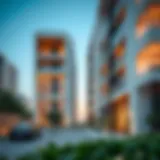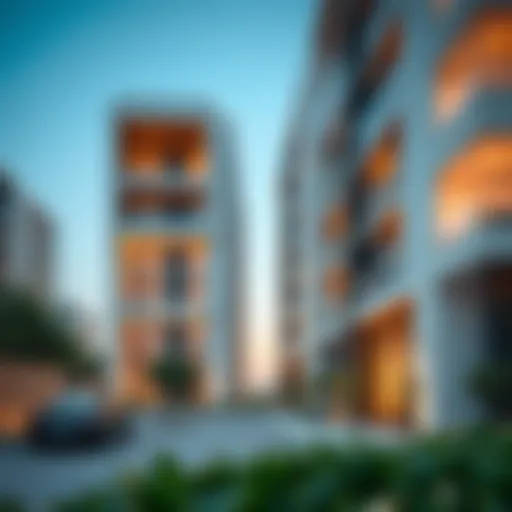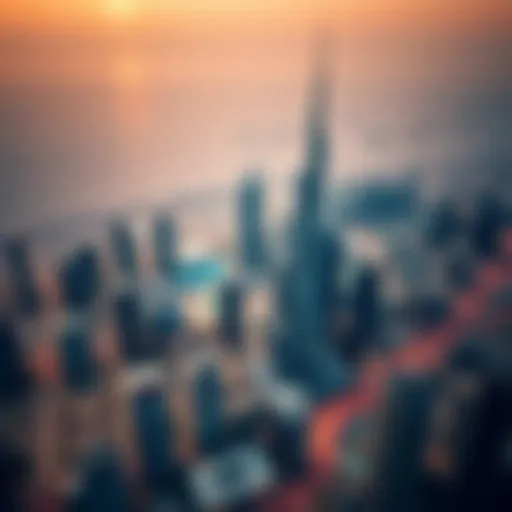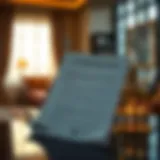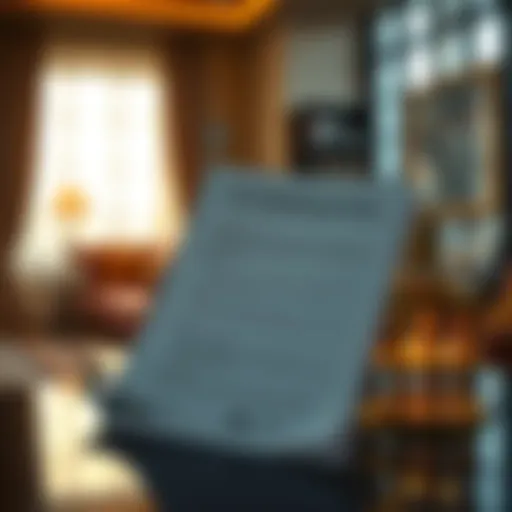Discovering the Allure of UAE's Traditional Markets


Intro
The traditional markets, or souks, of the United Arab Emirates (UAE) play an irreplaceable role in the socio-economic fabric of the region. These markets are not merely a collision of colorful stalls and packaged goods, but are vibrant, living museums showcasing the culture, history, and communal heritage of the Emirati people. As we tread deeper into this article, we will explore not just the market trends and practices related to them, but also unravel the mystique that makes them magnetic spaces for locals and visitors alike.
The UAE's souks, from those specialized in spices and textiles to those filled with gold and antiques, tell tales that date back centuries. Their ability to adapt to modern influences while maintaining authenticity is a testament to their resiliency. This blending of the old and new creates a unique atmosphere, beckoning shoppers to negotiate prices, savor local flavors, and absorb the rich narratives embedded in every corner.
This article aims to provide insightful perspectives that can benefit investors, buyers, agents, designers, and analysts. By understanding the dynamics of traditional markets, one can not only appreciate their cultural significance but also their influence on the bustling economy of Dubai. Join us on this illustrative journey as we guide you through the intricate world of the UAE’s traditional markets, highlighting critical aspects such as market trends, buying advice, and more.
Preface to Traditional Markets
Traditional markets, often referred to as souks, are not just places where goods are bought and sold; they are cultural hubs, bustling with life and history. These markets serve as a testament to the rich heritage and vibrant commerce in the UAE, offering a unique glimpse into the traditions and social fabric of the region. As the UAE evolves with modern influences, these traditional markets stand resilient, bridging the past with the present, making their exploration essential.
Definition and Importance
Traditional markets, or souks, are open-air marketplaces typically known for their diverse range of products. Souks can feature everything from spices, textiles, and perfumes to gold and handcrafted goods. Their significance goes beyond mere shopping destinations; they embody the cultural identity of their respective communities. The importance of these markets can be summed up as follows:
- Cultural Exchange: Souks foster interaction between locals and visitors, offering a platform for cultural exchange. Each stall tells a story, showcasing the skills of artisans and the region's history.
- Economic Sustenance: Unlike chain stores that dominate modern retail, traditional souks support local economies. They encourage small businesses and help maintain employment within the community.
- Culinary Delight: The variety of spices, foods, and fragrances stimulate the senses and allow individuals to experience the authentic flavors of regional cuisine.
- Bargaining Culture: Souks often embrace a culture of negotiation where haggling is the norm, adding an engaging layer to the shopping experience.
Historical Context
The history of traditional markets in the UAE dates back centuries, serving as essential trading posts along ancient trade routes. These markets flourished as crossroad points for merchants, facilitating the exchange of goods between different cultures and civilizations.
Archaeological findings suggest that souks have existed in the region since before the advent of the oil boom, underlining their importance in a society that relied heavily on trade. Merchants would gather to sell goods like pearls, textiles, and spices, creating vibrant social environments.
The evolution of souks reflects not only the economic shifts in the UAE but also social changes. As Dubai transformed into a global city, the souks adapted to modern influences while preserving their traditional charm. This blend of the new and the old provides a unique environment for both locals and tourists, making souks an enduring icon of the UAE's identity.
"Exploring these markets offers more than just shopping; it grants an immersive cultural experience unlike any other."
Through understanding the definition, importance, and historical context of traditional markets, we can appreciate their role as more than just commercial spaces but as vital components of the UAE's rich cultural tapestry.
Types of Souks in the UAE
The souks of the United Arab Emirates are more than just marketplaces; they embody the essence of the country’s heritage, blending trade with tradition. Each souk has its own character and specialized goods, making them pivotal to understanding the cultural fabric of the UAE. This section pays tribute to the various types of souks, highlighting their distinct offerings, and illustrates why they captivate both locals and visitors alike. To delve into the soul of the UAE, one must navigate through these bustling markets, where every stall has its own story to tell.
Gold Souks
When one thinks of luxury in the UAE, the Gold Souk undoubtedly comes to mind. Located primarily in Dubai, this marketplace is laden with eye-catching displays of jewelry that gleams under the warm sun. The allure of the Gold Souk lies not just in the sheer volume of gold available—reports often suggest over 10 tons of gold are showcased—but also in the craftsmanship of the pieces.
Most stalls offer intricate designs ranging from traditional to contemporary, catering to every taste. Shoppers can observe skilled artisans at work, often customizing pieces for individual clients on the spot.
What sets the Gold Souk apart is its vibrant atmosphere, echoing with the sounds of bargaining and lively chatter. Here, haggling is not just customary; it’s part of the cultural experience. In this bustling marketplace, buyers can save a significant amount if they're sharp and ready to negotiate.
"Gold does not merely glitter; it tells tales of generations and cultures—a timeless connection to heritage."
Spice Souks
Moving from the glimmer of gold to the robust aromas of the Spice Souk, visitors are enveloped in an intoxicating blend of scents. This marketplace is a treasure trove of spices, herbs, and traditional remedies, reflecting the culinary diversity of the region. Here, shoppers can find everything from saffron to sumac, chili powders to cardamom, all piled high in colorful heaps.
The Spice Souk offers an experience for the senses; the vibrant colors, the myriad fragrances, and the passionate vendors create an atmosphere that invites exploration. Tourists often stop to sample and learn about spices integral to Emirati cuisine. Buying spices isn't just about filling a bag; it's about connecting with the culture through flavors that have been used for centuries.
Textile Souks
The Textile Souk, situated in areas like Bur Dubai, invites visitors into a kaleidoscope of colors and textures. Here, bolts of fabric are displayed, each telling a story through its intricate patterns and rich hues. From luxurious silks to breathable cottons, the variety is staggering, appealing to fashion enthusiasts and craft aficionados alike.
In the textile lanes, you'll find something special: traditional Emirati attire, including the flowing abayas and vibrant kurta coats. Additionally, numerous shops offer the option to tailor garments on-site, providing a personal touch to every purchase. The artistry in the textiles signifies the cultural mix present in the Emirati identity, blending influences from the East and the West.
Perfume Souks
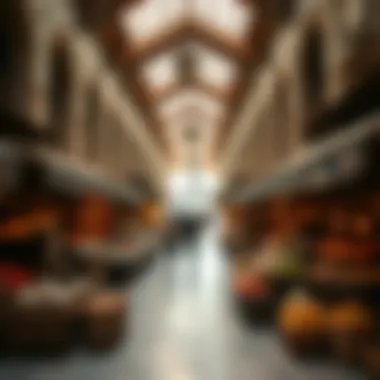

Finally, one cannot overlook the Perfume Souk, where the air is thick with the alluring fragrances of oud and bakhoor. This marketplace offers a unique experience unlike any other, where customers can discover traditional Middle Eastern perfumes as well as contemporary scents. Skilled perfumers create unique fragrances tailored to individual tastes, making the art of perfume a personal journey.
Shoppers can learn about the history of different scent profiles and their significance within Emirati culture, engaging in conversations with knowledgeable sellers who are passionate about their craft. The Perfume Souk encapsulates the spirit of Arabian hospitality, inviting all who enter to find their signature scent in a realm saturated with rich, aromatic history.
Cultural Significance of Souks
The cultural significance of souks within the UAE transcends mere shopping experiences; souks are lively monuments to the region’s heritage, reflecting the rich tapestry of Emirati life. They are not just marketplaces; they symbolize a way of life, fostering community bonds and preserving traditions. Understanding this cultural context is crucial for investors, buyers, agents, designers, and analysts alike, as it connects the dots between cultural nuances and economic prosperity.
Social Interactions
At the heart of souks lies a vibrant space for social interaction. Visitors and locals meander through bustling alleys, exchanging greetings and engaging in conversations that create a friendly atmosphere. This communal engagement is not incidental but rather a foundation of Emirati culture. Traditional phrases, way of bargaining, and exchanges often convey more than just the price of goods; they carry layers of meaning and history.
- Building Relationships: Frequent patrons help cultivate relationships with shopkeepers, leading to better deals and personalized recommendations. This aspect of social capital is invaluable.
- Cultural Exchange: Souks serve as a melting pot for different cultures, especially in tourist-heavy areas like the Dubai Gold Souk. Tourists and expatriates encounter local customs, which can foster a greater appreciation for Emirati traditions.
- Public Space: Unlike sterile shopping malls, souks contribute to the urban fabric by functioning as public gathering spaces where events, festivals, and cultural activities unfold.
In short, the social dynamics of souks elevate the market beyond glass-and-steel structures, imbuing it with purpose and heritage.
Cultural Preservation
The role of souks in cultural preservation cannot be overstated. They act as living museums, showcasing traditional crafts and local produce that might otherwise fade into obscurity. Artisans, vendors, and local producers maintain age-old techniques, offering not just products but also stories. This preservation of heritage illustrates the skill sets that have been passed down through generations.
- Tradition in Craftsmanship: Whether it’s the intricate artistry of goldsmithing in the Gold Souk or the fragrant spices meticulously arranged in the Spice Souk, each item represents a craft honed over centuries.
- Educational Aspect: Souks provide an educational dimension for visitors who wish to learn about Emirati customs, foods, and crafts. Workshops demonstrating traditional practices often entice participants, bridging the gap between past and present.
- Support for Local Economies: By shopping in souks, consumers directly contribute to local artisans, ensuring the survival of traditional crafts. This economic model bolsters community sustainability.
"Souks are the pulse of the community, where every transaction is steeped in history and spirit."
For further understanding regarding the role of traditional markets in preserving culture, visit Britannica.
Similarly, to explore more about the social dynamics within the UAE, check out Wikipedia.
Hands-on experience in these markets can provide critical insights, making visits to places like the Deira Spice Souk a worthwhile endeavor.
Economic Impact of Traditional Markets
Exploring the economic impact of traditional markets in the UAE reveals not only their foundational role within local economies but also their considerable influence on the broader landscape of commerce and trade. Souks are more than just marketplaces; they are vibrant hubs where the pulse of the economy can be felt directly by the community and visitors alike. In this section, we will unravel how these markets contribute substantially to the local economy and how they play a pivotal role in tourism and hospitality.
Contribution to Local Economy
The contribution of traditional markets to the local economy is profound. Souks generate substantial revenues, offering both local artisans and international traders a platform to reach consumers. Here are some key aspects to consider about their economic importance:
- Employment Opportunities: These markets create a myriad of jobs. From goldsmiths in Dubai Gold Souk to spice vendors and textile merchants, countless families rely on the livelihood generated by these traditional hubs.
- Support for Local Producers: Souks often serve as the first point of sale for many local producers, allowing them to showcase and sell their goods directly to consumers. This direct-to-consumer model promotes local products, ensuring sustainable practices while enhancing the regional economy.
- Revenue Generation: Traditional markets are significant contributors to local revenues through various fees, ranging from business licenses to rental payments for stalls. This financial activity fuels municipal services and local infrastructure developments.
- Cultural Exchange: Souks promote cultural exchange among diverse visitors and traders, enhancing the tourist experience. This interaction can lead to increased spending in neighboring businesses, creating a ripple effect of economic benefits.
"The vibrant atmosphere of a souk isn’t just about shopping. It’s about experiencing culture; it’s a doorway to the local economy at its finest."
Tourism and Hospitality Influence
The influence of traditional markets on tourism and hospitality in the UAE cannot be overstated. Visitors flock to these bustling souks, drawn by the rich tapestry of experiences they offer. Consider the following points that highlight their significance:
- Tourist Attractions: Many souks, like the Deira Spice Souk and Dubai Gold Souk, have become must-visit tourist attractions. Their unique offerings not only draw visitors but also promote the UAE’s cultural heritage.
- Encouraging Spending: Tourists often allocate a significant portion of their budgets to shopping in souks. This spending directly impacts local businesses, boosting sales and supporting the economy at large.
- Enhancing Hospitality Offerings: The presence of traditional markets enriches the hospitality sector. Hotels and tour operators package visits to souks as part of their offerings, creating a unique blend of experiences for guests while supporting local businesses that populate these markets.
- Cultural Experiences: Souks contribute to creating cultural experiences that are attractive to tourists seeking authenticity. This not only helps sustain the markets but also preserves the cultural identity that plays a pivotal role in the UAE's economic landscape.
Bargaining Culture
Bargaining is more than just a means to an end in the traditional markets of the UAE; it is an art form steeped in history and cultural significance. In a world increasingly dominated by fixed prices and digital transactions, the vibrancy of the souk bargaining experience reflects a compelling connection to heritage. Here, every haggling exchange tells a story, reinforcing the bond between buyers and sellers.
The act of bargaining fosters social interaction, creating a dynamic exchange not only of money but of ideas and cultural values. Vendors, with their rich knowledge of products, engage potential customers in conversations, often sharing the histories behind their goods. This interaction creates a marketplace atmosphere that is both personal and welcoming, inviting shoppers to become a part of a lively tradition.
Understanding the Negotiation Process
The bargaining process in the souks of the UAE embodies a unique blend of strategy, psychology, and cultural nuance. Right from entering a souk, negotiation begins with an open mind and an eagerness to engage. The first step is to assess both the item in question and the seller’s demeanor. For instance, when a seller first quotes a price, it is often inflated, a technique used to allow for room to negotiate. Understanding this principle is crucial for any buyer.
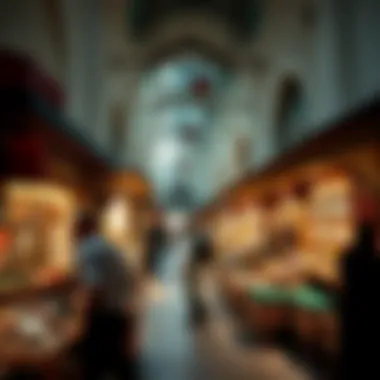

One might start the process by expressing an interest in an item, which gives the seller a cue to engage. Following that, buyers usually suggest a lower price, and the negotiations ensue, with both parties presenting their arguments. These interactions are usually lively and can involve a fair amount of back-and-forth banter. The key is to approach negotiations with respect and a sense of humor; this can often lead to both parties walking away satisfied.
Tips for Successful Bargaining:
- Do Your Research: Have an idea of the average price for the item you're interested in.
- Start Low: Begin with a price lower than what you are willing to pay.
- Be Patient: Don’t rush the process; taking your time can often lead to a better deal.
- Walk Away: If you are not getting the deal you want, be prepared to leave. This can sometimes prompt the seller to reconsider.
Psychological Aspects of Bargaining
When delving into the psychology of bargaining, one must consider the emotional factors at play. The thrill of finding a deal can evoke a sense of accomplishment, while the fear of being overcharged can generate anxiety. This interplay affects how both buyers and sellers approach the bargaining table.
For sellers, recognizing their customers' cues is vital. A keen seller can observe body language and listen for words that indicate the buyer's willingness to negotiate. Conversely, buyers often engage in psychological strategies as well. They may use tactics like expressing disinterest or engaging in light-hearted banter to create a friendly atmosphere while still keeping the price down.
Moreover, the act of bargaining itself can engage a sense of identity. For many locals, it is not just about saving money; it’s about participating in a cultural ritual that connects them to their history. This emotional investment can make the final purchase far more meaningful, elevating a simple transaction into a memorable experience.
Modern Influences on Traditional Markets
The traditional markets, or souks, found in the UAE are increasingly shaped by modern influences, which bring both opportunities and challenges. Understanding these influences is essential for investors, buyers, and designers keen on evaluating the evolving landscape of these cultural hubs. Traditional markets face an intriguing blend of preservation and upgrade, as urbanization and technology redefine how they operate and serve both local and tourist populations.
Among the various elements that characterize modern influences, two stand out: urban development and e-commerce integration.
Impact of Urban Development
Urban development plays a pivotal role in transforming traditional markets in the UAE. As cities expand and modernize, the physical landscape of these markets often undergoes significant changes. For instance, the influx of high-rise buildings in Dubai has led to a spatial rearrangement of local souks. The proximity of these souks to luxurious hotels and shopping complexes can be both a boon and a bane.
As accessibility increases, more consumers flock to these markets, breathing new life into them. Yet, this growth can come at a cost; the essence of traditional exchanges may become diluted under the pressure of commercialism and a more homogenized retail experience. Vendors may find themselves pressured to adapt to the fast-paced demands of the modern consumer.
"As urban spaces evolve, the heart of the souk must beat louder to retain its soul."
Local governments are aware of these shifts and often undertake initiatives to strike a balance between modernization and heritage conservation. More green spaces or pedestrian pathways can create a vibrant, inviting atmosphere without overshadowing the unique character that the souks are known for. Adaptability is the name of the game, as the blend of old and new must coexist harmoniously to attract varied demographics.
E-commerce Integration
E-commerce integration represents another modern influence beginning to permeate the fabric of traditional markets. The accessibility of online shopping platforms has forced local traders to adapt, and many are now leveraging technology as a way to bridge the gap between physical and digital realms. Platforms such as Souq.com, now integrated into Amazon, provide opportunities for local merchants to reach a wider audience outside their immediate vicinity.
This integration is not merely about selling; it offers fresh pathways for branding and marketing unique local products globally. Local artisans benefit significantly from this shift, presenting their unique offerings—from handcrafted textiles to traditional spices—on a global stage.
Yet, this evolution isn't without its challenges. Many traditional market vendors struggle with the intricacies of e-commerce, from logistics to digital marketing. As always, with new opportunities come the need for education and resource allocation.
The interplay between traditional shopping experiences and online platforms can ultimately redefine consumer habits and preferences. While foot traffic in souks may decline, the enveloping charm of in-person shopping remains irreplaceable for those yearning for a taste of cultural authenticity.
The Role of Souks in Dubai Real Estate
The souks of Dubai are not merely markets; they hold considerable sway in the city's real estate dynamics. Located in diverse areas, these traditional markets serve as not just retail hubs but also cultural icons that can influence property values and the desirability of residential areas. Understanding their role provides valuable insight for investors, buyers, and real estate professionals, emphasizing how they contribute to the broader market strategy.
Proximity to Residential Areas
When it comes to real estate, location is everything. The proximity of souks to residential neighborhoods adds an undeniable charm and practical appeal. For many residents, the convenience of having a vibrant market nearby enriches daily life. Imagine waking up and having fresh spices or artisanal products just a stone's throw away.
In areas like Deira and Bur Dubai, the existence of souks fosters a unique community atmosphere. These markets offer an array of products—from luxurious gold to fragrant spices—drawing in residents who value accessibility and variety. For developers considering new residential projects, having a souk nearby can significantly enhance the appeal of the property. High foot traffic generated by the souks can lead to increased interest in the surrounding real estate, making residential areas more attractive to potential buyers.
Here are some key benefits of having souks close to residential areas:
- Cultural Enrichment: Living near a souk allows residents to immerse themselves in the local culture, fostering a strong community sense.
- Convenience: Access to fresh produce, spices, and traditional goods means residents can enjoy a more convenient lifestyle.
- Increased Demand: Properties adjacent to vibrant souks often command higher demand, benefiting sellers and landlords.
"The proximity of traditional markets to living spaces highlights not only modern convenience but also cultural authenticity, a rare blend in today’s fast-paced urban environments."
Effect on Property Values
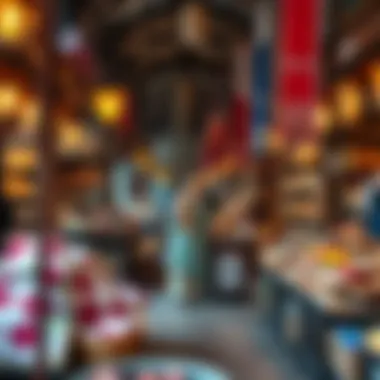

The relationship between traditional markets and property values is a multifaceted one. Neighborhoods enriched by the presence of souks often see a marked increase in property values, driven by heightened desirability. When buyers perceive an area as vibrant and culturally rich, they are willing to invest more.
Economically, the local sales generated from these markets contribute to the overall vitality of the area. A bustling souk can attract tourists, enhance local businesses, and create job opportunities, all of which feed back into the property market. More businesses and increased foot traffic can elevate demand for residential properties, and subsequently, their prices.
Some notable factors include:
- Market Activity: An active souk often indicates a thriving area where demand for housing can multiply, thus inflating prices.
- Cultural Value: Properties in culturally rich neighborhoods, especially those near souks, often carry a premium due to their historical significance.
- Long-Term Investment: For homeowners and investors, properties near souks are often seen as safer long-term investments due to their consistent demand.
Case Studies of Notable Souks
Examining specific souks offers us a window into the heart of the UAE's traditional markets. Each souk presents a unique tapestry woven with threads of history, culture, and trade, shining a light on the broader implications for investors, buyers, agents, designers, and analysts.
Dubai Gold Souk
The Dubai Gold Souk is not just a market; it's an iconic showcase of opulence and tradition. As one of the largest gold markets in the world, it features over 300 retailers, offering an incredible variety of gold jewelry, ranging from intricate traditional pieces to modern designs. The importance of this souk lies not only in its vast selection but also in how it represents the UAE's deep-rooted connection to trade and craftsmanship.
Visitors often find themselves wandering through narrow alleys lined with shops adorned by striking displays that catch the eye. The souk also serves as a vital hub for international trade, hosting buyers from across the globe, thus boosting the local economy and contributing to Dubai's reputation as a luxury shopping destination.
"The gold souk is a reflection of Dubai's economic prosperity and its links to ancient trade routes."
Deira Spice Souk
The Deira Spice Souk is a sensory feast. The moment you step into this labyrinth of stalls, the air thickens with the rich aromas of spices, herbs, and blends from every corner of the world. It's not just about food; it encapsulates the essence of cultural exchange that the UAE has nurtured over the years.
This souk is essential for buyers looking for unique spices, rare ingredients, and traditional remedies. Local businesses thrive here, supported by the foot traffic of both tourists and residents alike. For agents and designers, the spice souk offers a canvas of colors and scents that can inspire culinary arts and home decor, fostering creativity and innovation. In a world heading towards automation, the personal touch found here remains charming.
Sharjah Central Market
The Sharjah Central Market, often referred to as the "Blue Souk," is renowned for its stunning architecture and diverse offerings. It's not merely a shopping destination but also a hub for cultural activities. The market features a wide range of products, including textiles, jewelry, and traditional handicrafts.
The market's strategic location enhances its significance, as it's in the heart of Sharjah, which is often considered the cultural capital of the UAE. For investors and analysts, the Sharjah Central Market represents ample opportunities; its focus on local artisans and traditional products resonates well with consumers seeking authenticity and sustainability in their purchases. The market plays a crucial role in preserving Sharjah's heritage while adapting to modern demands.
In summary, these case studies of notable souks in the UAE provide valuable insights into the intricate relationship between tradition and modernity. They highlight the importance of preserving cultural identity while embracing global trade dynamics, making them vital not just for local heritage, but for economic prosperity as well.
Future of Traditional Markets
The vitality of traditional markets in the UAE lies not just in their historical significance but also in their adaptability to changing times. The future of these souks hinges on navigating the complexities of modern influences while preserving their unique charm. Investigating the potential obstacles and the avenues for growth presents a comprehensive outlook that is crucial for investors, buyers, agents, designers, and analysts.
Potential Challenges
While the prospects look promising, the road ahead is not without its bumps. Several factors can pose significant challenges to the traditional market landscape in the UAE:
- Urban Development Pressure: High-rise buildings and shopping malls are almost synonymous with urbanization. As more luxurious malls emerge, these souks might lose their customer base, drawing shoppers away with convenience and modernity.
- Changing Consumer Preferences: The shift towards e-commerce has become increasingly prevalent. Younger generations, especially, tend to favor online purchases for their speed and ease, which might diminish foot traffic in traditional markets.
- Regulatory Hurdles: Government regulations could also impact the operations of these markets. Stricter laws on street vendors or selling practices could limit the flexibility that makes these souks vibrant and lively.
- Cultural Erosion: With globalization, there's always a risk of losing the cultural significance that these markets embody. Outside influences can dilute the authentic experiences that locals and tourists seek.
Ending
Traditional markets, or souks, in the UAE are not merely shopping destinations; they represent a thriving amalgamation of history, culture, and economic dynamism. This article has navigated through various aspects of these markets, underscoring their profound importance.
Summary of Key Points
- Cultural Significance: Souks are a microcosm of local customs and traditions, weaving social interaction with trade. They are vital for the preservation of Emirati identity, showcasing local craftsmanship through various goods such as textiles, spices, and perfumes.
- Economic Contributions: As discussed, traditional markets play a significant role in bolstering the local economy. They attract residents and tourists alike, contributing significantly to the UAE’s financial landscape. The bargaining culture prevalent in these souks fosters an engaging shopping experience that enhances consumer participation and generates revenue.
- Modern Adaptations: Despite the pressures of urban development and the rise of e-commerce, traditional markets are successfully adapting to maintain their relevancy. This adaptability ensures their survival, blending heritage with modern convenience.
- Real Estate Influence: Souks influence property values by attracting foot traffic, making their locations desirable for real estate investment. As more residents seek the essence of tradition combined with modern living, properties nearby these markets gain appeal.
- Future Outlook: The ongoing challenges posed by modernization and competition demand that these markets innovate while retaining their charm. Opportunities abound for growth, particularly in enhancing the tourist experience while preserving the local flavor.
Final Thoughts
In summary, the traditional markets of the UAE embody a critical intersection of culture and commerce, making them indispensable in today’s rapidly changing environment. As investments in these areas grow and attention increases, the charm of the souk remains rooted in community, tradition, and the vibrancy of local economic activity. The resilience of these markets speaks volumes about the human spirit's tenacity in the face of change. It is essential for future investors, traders, and designers to immerse themselves in the essence of these souks, ensuring they thrive amid the evolving landscape of the UAE.
"Preserving the past while embracing the future is the key to success in today's fast-paced world."
Relevant Links
- Wikipedia - Souks in the UAE
- Britannica - Traditional Markets
- Realtor Insights - The Impact of Souks on Real Estate
- UAE Tourism
The future of UAE’s traditional markets looks bright, and as we keep our eyes on these venues, they will continue to charm both locals and visitors for many years to come.


